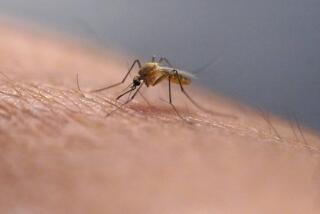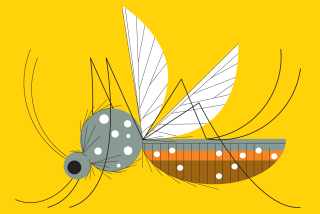Using genetics to try to figure out how to get mosquitoes to stop biting us
Among all the beasts in the animal kingdom, perhaps none is more dangerous to humans than the mosquito.
The whiny insects aren’t just irritating — they can be deadly.
In fact, the U.S. Centers for Disease Control and Prevention reckons that mosquitoes are responsible for at least 700,000 deaths worldwide each year, thanks to their ability to transmit diseases such as malaria and yellow fever with a single bite.
That makes the bugs 50,000 times more deadly to humans than sharks, according to the CDC.
To thwart these tiny flying assassins, researchers have developed a range of strategies including insecticides, sterilization programs and repellents like Deet. Now, scientists think mosquito genetics will help them add a new weapon to that arsenal.
“In order to figure out how to deal with mosquitoes, we first have to understand them,” said Matt DeGennaro, a mosquito neurobiologist at Florida International University in Miami.
DeGennaro’s work focuses on a specific species of mosquito called Aedes aegytpi. It’s a small, stealthy insect that is highly adapted to living with humans.
This species was first spotted in Southern California in 2014, and they’ve been spreading since then. Unfortunately for us, it doesn’t take much for them to propagate: their eggs can hatch in a quarter-inch of water inside an upturned bottle cap, and even in the depression of a wrinkled chip bag that gets hit by a sprinkler.
Female mosquitoes require a blood meal to lay their eggs (males don’t bite), and female Ae. aegypti prefer to bite humans. In the process, they can become infected with viruses that cause Zika, dengue, yellow fever and chikungunya. The viruses don’t trouble the mosquitoes, but they can sicken the next human unlucky enough to be bitten (or the one after that, or the one after that ...).
“I think they are amazing, and as a scientist I love studying them, but I realize that my end goal is to thwart them,” DeGennaro said. “It’s kind of like we are frenemies.”
For the last several years, DeGennaro has been trying to understand how mosquitoes find humans to bite, and which genes help them do it.
“That information is really important, because once we learn how those sense receptors work, then we can manipulate them with repellents,” he said.
Previous work has shown that female Ae. aegypti rely on a series of chemical cues to detect a human host.
First she gets a whiff of the carbon dioxide we exhale, which she can sense from more than 30 feet away. This alerts her to the presence of a vertebrate nearby.
“It’s kind of like coffee for mosquitoes,” DeGennaro said.
Then she flies in closer to get a whiff of our body odor, hoping to identify the unique and complex blend of compounds that tells her the CO2 source is indeed human.
Next, she’ll fly even closer to see if she can sense our body heat. This confirms that we are indeed living, breathing — and full of blood.
Finally she lands, tasting our skin with sensors on her legs.
“At this moment they are experiencing all the cues at once, and it must be very intoxicating,” DeGennaro said. “The mosquito is thinking, ‘I don’t care if you are going to swat me, I’m going to bite you.’”
All vertebrates exhale CO2 and most release body heat, so scientists have concluded that there must be a unique human aroma that guides Ae. Aegypti straight to us. And there must be a gene (or several) that help them do it.
In a previous study, DeGennaro used the gene-editing system CRISPR-Cas9 to knock out the gene for an odor receptor on their olfactory neurons to see how it would affect a mosquito’s ability to find a human to bite. Sure enough, mutant mosquitoes without the gene for the receptor, called Orco, had more trouble than regular mosquitoes at differentiating between humans and other animals.
But even without Orco, they were still able to find humans. This meant there had to be other odor receptors that allowed them to locate humans.
So DeGennaro tried again. In a new study, he used CRISPR to disrupt the gene for a different odor receptor known as IR8a.
He picked this gene because it is expressed only in mosquito antennae, and the antennae are what mosquitoes use to sniff their environment, he said.
In one of the first experiments, the researchers inserted an electrode in the mosquito antennae to measure the electrical activity they generated in the presence of lactic acid and CO2. (Lactic acid is a key component of human odor, and one that differentiates us from other animals.)
Mosquitoes without a functional IR8a gene did not respond at all to lactic acid or to other acidic chemicals emitted by humans, while mosquitoes with a normal version of the gene did.
Next, the researchers compared the behavior of female mosquitoes with and without the IR8a gene by putting the insects in a plastic tube with an odor box attached upwind of it. If the mosquitoes were attracted to what they sensed in the box, they would fly toward it and get stuck in a small trap.
Using this contraption, they found that in the presence of CO2 and human odor — provided by a human arm or a nylon stocking that had been rubbed on human skin — 75% of the unaltered mosquitoes got stuck in the trap, compared with 50% of the IR8a mutants.
In another experiment using an artificial blood feeder, 75% of normal Ae. Aegypti would feed in the presence of CO2, human odor and heat, compared with around 30% of the mosquitoes whose IR8a gene had been knocked out.
The results, published Thursday in Current Biology, demonstrate that the IR8a gene plays an important role in helping female mosquitoes find humans. This gives scientists a potentially useful target for keeping mosquitoes away from us.
However, there is still more work to do.
“It is a significant advancement in the field, but it is not a silver bullet,” said Walter Leal, who studies insect olfaction at UC Davis and was not involved in the new study. “Even if we were to generate transgenic mosquitoes that lack IR8a, mosquitoes would find humans and other vertebrates in the environment.”
Christopher Potter, a neuroscientist specializing in insect olfaction at Johns Hopkins University School of Medicine, said that although the work convincingly demonstrates that IR8a is important for human attraction in mosquitoes, it does not address the gene’s role in identifying humans in particular.
“Would Ir8a mutant mosquitoes show defects in distinguishing humans from other animals? Or are Ir8a mutants just defective in attraction to animals in general?” said Potter, who didn’t work on the study. “That remains to be determined.”
DeGennaro said his next steps are to identify the genes that work with IR8a to detect the lactic acid in human sweat.
He also plans to start looking for other compounds besides lactic acid that can activate the IR8a receptors in mosquitoes, as well as odors that might block them. The first type of molecule could be used to create a trap that draws mosquitoes away from humans; the second type could make humans less attractive to mosquitoes.
“Our goal is to figure out how mosquitoes find people and then use that information to create a life-saving perfume,” DeGennaro said.
Fighting mosquitoes with mosquitoes: Biological weapons target Zika virus »
Do you love science? I do! Follow me @DeborahNetburn and “like” Los Angeles Times Science & Health on Facebook.







